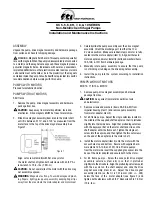
Operating Instructions And Parts Manual
6
For replacement parts or technical assistance,
call 1-888-636-6628
Please provide following information:
- Model number
- Serial number (if any)
- Part description and number as shown
in parts list
Address parts correspondence to:
Blue Angel Pumps
101 Production Drive
Harrison, OH 45030 U.S.A.
1
Volute
56603
1
2
Volute wear ring
23112
1
3
Impeller
SEE CHART
1
4
Shaft seal kit
56884-002
1
5
Seal plate
56604
1
6
Cover gasket
16855
1
7
Ball Bearings (Furnished with Motor)
1
8
Capacitor
3/4 HP to 2 HP
23126-002
1
1/2 HP only
23126-002
1
9
Locking cable tie
16634
1
10
Pipe Plug 1/4 Hex Socket HD.
16314
1
11
Lifting eye
23124
1
12
Power supply cord
SEP 5, 6, 7, & 8
23125-002
1
SEP 4
23163-001
1
16
1/2 - 13 UNC x 2 1/4 Hex HD.
16636
4
18
Motor housing
56605-001
1
19
Motor
SEE CHART
1
20
3/8 - 16 UNC x 1 1/4 Socket head
16798
3
21
1/2 - 13 UNC x 2 1/4 Hex HD.
16636
2
22
Discharge flange 2”
56606-001
1
Discharge flange 3”
56606-002
1
23
2” Discharge gasket
23101
1
3” Discharge gasket
23102
1
24
Washer
16635
4
25
1/2 - 13 UNC Hex nut machine screw
16637
2
26
Dielectric oil (1 gallon)
56435
1
27
Volute gasket
16735
1
MOTOR / IMPELLER CHART
H.P.
Motor Part Number
Impeller Part Number
1/2
3710-004
84341
3/4
3710-005
84342
1
3710-006
84343
2
3710-008
84345
Ref.
No. Description
Part Number Qty
Ref.
No. Description
Part Number Qty
5. A check valve
MUST
be used in a
solids-handling system. Mount the
check valve in a horizontal position
or at a 45º angle with the valve
pivot on top. In a vertical position,
solids tend to lodge on the valve
flapper and can prevent it from
opening.
6. Drill a 1/16” hole in the discharge
pipe 1 to 2 inches above the flange.
This will prevent air locking and loss
of prime at startup. A gate valve
should be installed in the system
after the check valve. This gate
valve should be a full port valve
which will pass 2” solids or as
required by state and local codes.
The gate valve permits removal of
the pump and/or the check valve for
servicing (and will minimize
backflow mess).
7. (OPTIONAL) Install a union between
the check valve and the pump so
the pump can be removed with the
least amount of disturbance of the
piping.
8. Connect 2” rigid pipe to check
valve.
Installation
(Continued)
INSTALLATION BASICS:
1. NEVER lift this product by the
electrical cords.
2. Install pump in a sump pit that
fulfills the minimum size
requirements (24” minimum).
Construct sump pit of tile, concrete,
steel or plastic. Do not install a pit
smaller than recommended.
3. The unit should be located and rest
on a solid, level foundation. Do not
place pump directly on clay, earth,
gravel or sandy surface. These
surfaces contain small stones,
gravel, sand, etc. that may clog or
damage the pump and cause pump
failure.
Flood risk. If flexible discharge hose is
used, make sure pump is secured in
sump pit to prevent movement. Failure
to secure pump could allow pump
movement and switch interference and
prevent pump from starting or
stopping.
4. Thread the discharge pipe or pipe
nipple into the discharge flange
connection.
3
Operating Instructions And Parts Manual
Support pump and piping when
assembling and after installation.
Failure to do so could cause piping to
break, pump to fail, etc. which could
result in property damage and/or
personal injury.
9. Protect electrical cord from sharp
object, hot surfaces, oil and
chemicals. Avoid kinking the cord
and replace damaged cords
immediately.
IMPORTANT:
Make sure there is
adequate room for tether switch to
swing freely during operation.
10. A pit cover must be installed to
prevent debris from clogging or
damaging the pump. All piping and
power cords will be brought
through the appropriate openings
in the basin cover. Do not modify
existing openings in any way.
All sewage basins must be vented to
prevent a build-up of methane gas.
Consult your local codes for proper
venting. DO NOT install venting in
locations classified as hazardous in
accordance with the National Electrical
Code NFPA 70.
Figure 4 - Typical Installation
Main
waste line
to sewer
or septic
tank
Upper level drainage
Three prong grounded
outlet equipped with a
ground fault interruptor
2” Discharge
pipe
Float switch
Pump
Cleanout
Vent pipe
2” Gate
Valve
Union
2” Check
Valve
45
o
Elbow
Laundry tubs
Washer
Dryer
Floor drain
Washer drain
Lavatory
Shower
Flange
www.blueangelpumps.com
www.blueangelpumps.com






















